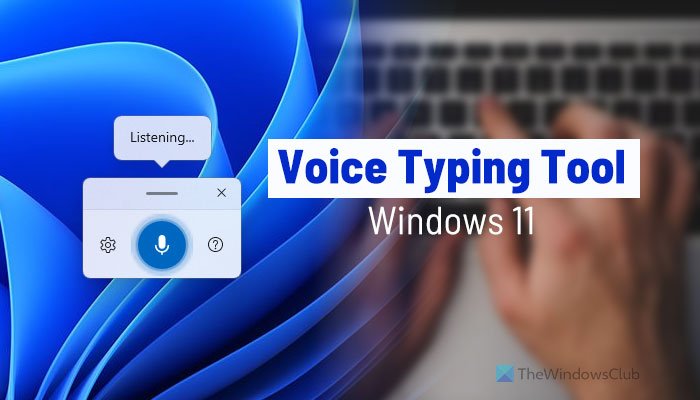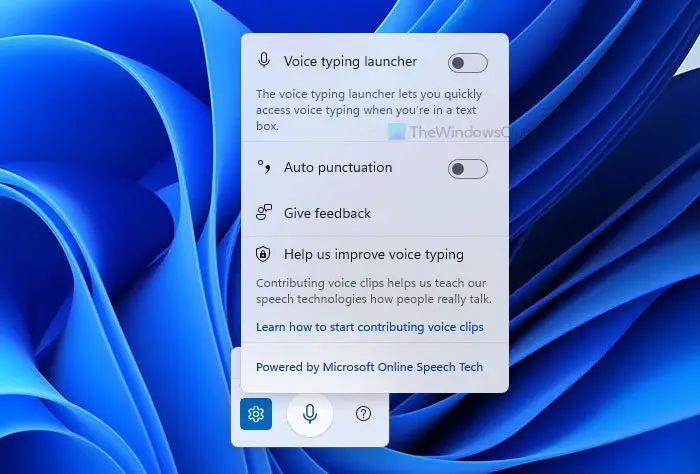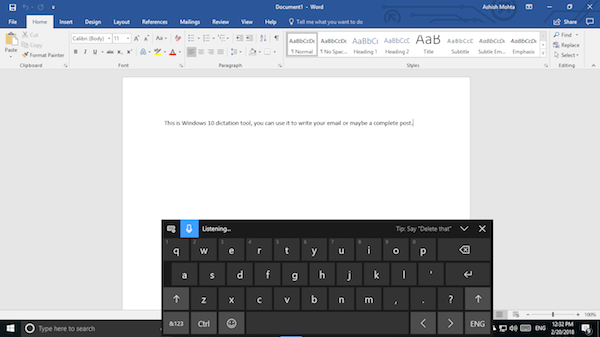If you want to use Voice Typing or Dictation Tool in Windows 11/10, here is how you can set things up on your computer. It is built into your Windows 11-installed laptop as well as desktop computers. By default, Windows 11 enables this feature, and you need to use the keyboard shortcut to activate and start using the Voice typing feature.

If you have always thought of writing posts, emails, or anything on your Windows computer using voice, Microsoft offers a native Dictation feature in Windows 11/10. This tool can translate your spoken words into text, and it works in any app with a text input and can also be used on the desktop to launch settings and other things.
Voice typing is probably the greatest companion to those who write thousands of words every day. In simple terms, you can convert your voice into text with the help of the Voice typing tool. That said, you can type in any word processing app, browser, or anywhere with the help of a voice command. All you need to say is the words you want to type in the desired app.
How to use the Voice Typing or Dictation Tool in Windows 11
To use the Voice Dictation or Typing Tool in Windows 11/10, follow these steps:
- Open the app in which you want to type.
- Press Win+H keyboard shortcut.
- Click on the microphone icon to start.
- Start saying something you want to type.
- Click on the microphone button to stop.
Let’s learn more about these steps in detail.
To get started, you need to open an app in which you want to type. Once the app is opened on your screen, you can press the Win+H keyboard shortcut to open the Voice typing tool.

You need to click the microphone icon visible in the middle of the pop-up window to activate it. If you can see the Listening message and beep sound, you can start saying anything you want to be typed.

Once your dictation is complete, you can click the blue microphone icon to stop it.
Related:
Windows 11 Voice typing tool settings

Voice typing tool is a simple and uncluttered app that does what it is meant for. To spruce up the experience, it offers two options that you can find by clicking the settings gear icon. Those two options are:
- Voice typing launcher: It opens up the launcher automatically when you click on a text box.
- Auto punctuation: It formats the sentences automatically if you turn this feature on.
You can toggle the respective button to enable or disable these two options quickly.
Read: How to turn off Touchpad Tap to Click on Windows 11.
How do I use the Voice typing tool?
To use the Voice typing tool in Windows 11, you need to press the Win+H button. It is the keyboard shortcut to open the Voice typing tool on your computer. Following that, you can click on the microphone icon to start dictation. Once done, you can click the same microphone icon to stop this feature from listening to your voice.
How do I use voice to text on my computer?
To convert your voice to text on your computer, you can use the Voice typing tool in Windows 11. It is one of the best tools you can find to get the job done. As it is an in-built feature, you do not need to install third-party software. To get started, press the Win+H button together and click on the microphone icon.
Windows Dictation commands
This is the list of dictation commands you will need to use if you are planning to use this tool most of the time. Say for example if you want to delete a word where your cursor is, just say Delete word, and it will be done.
| To do this | Say |
| Clear a selection | Clear selection; unselect that |
| Delete the most recent dictation result, or currently selected text | Delete that; strike that |
| Delete a unit of text, such as the current word | Delete word |
| Move the cursor to the first character after a specified word or phrase | Go after that; move after word; go to the end of paragraph; move to the end of that |
| Move the cursor to the end of a unit of text | Go after word; move after word; go to the end of that; move to the end of paragraph |
| Move the cursor backward by a unit of text | Move back to the previous word; go up to the previous paragraph |
| Move the cursor to the first character before a specified word or phrase | Go to the start of the word |
| Move the cursor to the start of a text unit | Go before that; move to the start of that |
| Move the cursor forward to the next unit of text | Move forward to the next word; go down to the next paragraph |
| Moves the cursor to the end of a text unit | Move to the end of the word; go to the end of the paragraph |
| Enter one of the following keys: Tab, Enter, End, Home, Page up, Page down, Backspace, Delete | Tap Enter; press Backspace |
| Select a specific word or phrase | Select word |
| Select the most recent dictation result | Select that |
| Select a unit of text | Select the next three words; select the previous two paragraphs |
| Turn spelling mode on and off | Start spelling; stop spelling |
The Voice Dictation or Typing Tool is available in US English only. To use it, your PC needs to be connected to the internet. To dictate in other languages, use Windows Speech Recognition.
How to use Voice Typing or Dictation Tool in Word

Select a text area like a Word document or email where you want to type. Then to start the dictation tool, press Windows key + H on the keyboard. This will launch the voice dictation panel with a keyboard and blue microphone icon. It’s basically the touch keyboard that shows up in tablet mode for 2-in-1 laptops.
The blue microphone icon will immediately enter “Listening” mode, and you can start your dictation immediately. However, writing isn’t just putting in random words you speak; you need to add punctuation and other grammar aspects. We will talk about the dictation commands at the end of the post.
Once done, all you need to say is “stop dictating“, and then stop saying. Once the tool gets the silence, it will stop converting speech to text.
While compact, the keyboard is expected to occupy part of your screen. This means it will block your view of what’s in the document. I suggest you drag, and put it under the taskbar so it disappears from the visuals, but the dictation keeps working.
Read:
Leave a Reply